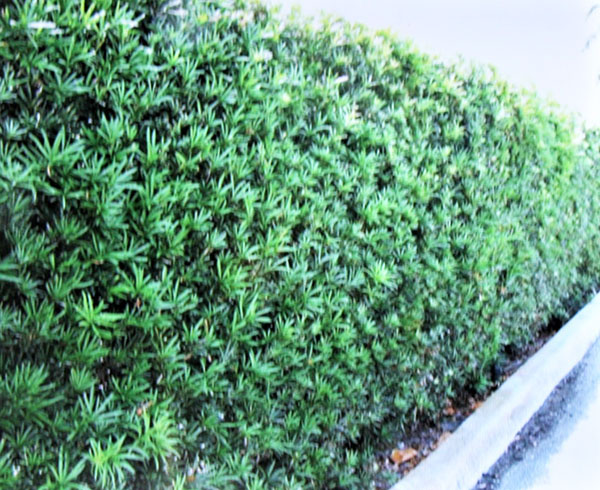Hedges are an important aesthetic to the Village of Wellington, and Planning & Zoning Manager David Flinchum led a presentation before Wellington’s Architectural Review Board on Wednesday, Aug. 21, explaining what the village would like to see along main thoroughfares, with a special note on what hedge plants thrive and others that should be avoided.
The discussion included a look at several residential properties along Forest Hill Blvd., where in some cases, fences and hedges lack uniform coverage, malfunctioning sprinklers do not allow plants to be watered sufficiently to thrive, or sometimes plant growth is combined with weeds and other invasive species.
“For those of you who have lived here a while, the Forest Hill Blvd. hedges have long been a topic of discussion,” Flinchum said. “It’s interesting how many times you drive by it. It’s when you actually walk it that you see a lot of things you don’t realize are there.”
Recently, Flinchum and his team have put a focus on hedge issues.
“For the past couple of months, we have been marking where these properties are along the thoroughfares, Flinchum said. “Tonight, we are going to concentrate on Forest Hill Blvd., which is a true thoroughfare. It starts outside the village to the east and then runs through the village.”
Flinchum focused on properties between Block Island and Guilford. He explained that there are eight open code cases at this time for hedge violations. Some of the properties are homesteaded, and others are landowners who are out of the area.
Flinchum showed the board various slides of hedges that were not up to code, and the reasons why they don’t live up to Wellington’s hedge standards. Then he showed slides in a PowerPoint presentation of hedges that were well-maintained with the look that the village is trying to implement.
Photographs of poorly maintained Ficus hedges show thick trunks with little vegetation. The fence is not covered at all by greenery.
“If you look at the trunks of a Ficus, once they get over four inches in diameter, they are never going to sprout,” Flinchum explained. “You can top them all you want, but it will not re-grow its skirt. The other problem I see is irrigation. Most of the properties I did see are disconnected or uprooted.”
Some property owners don’t have a gate through their fence line and have little access to the area that is growing the hedge, Flinchum noted.
“The problem I believe is that people don’t have the access [to the hedge],” he said. “It’s kind of out of sight, out of mind. A lot of these cases, I believe, will be coming to the magistrate probably in September. We will be working with them, recommending what they can do quickly to get them in compliance.”
Wellington amended the height of fences, walls and hedges based on the size of the property in 2015. The ordinance explains that “the hedge height requirements are essential in keeping a maintained appearance while ensuring safety and privacy for residents and travelers throughout the community and along the major thoroughfares.”
Homeowners should be aware of the plantings they choose, Flinchum said. They should make sure that the plants grow quickly, covering the fencing with plants that complement the fence material but also are in keeping with the look that the village is trying to promote.
Cocoplum or Chrysobalanus icaco is a plant that is recommended by the village. It is an evergreen, broad-leafed shrub with leathery leaves that range in color from green to light red. Some plants range from 3 to 9 feet tall, but others can get as tall as 30 feet.
Another recommended plant is Podocarpus. Hardy and low-maintenance, Podocarpus has cones with scales, which form a fleshy, berry-like, vessel. They can reach 130 feet high. These shrubs can become thick, lush and large enough to work as a privacy screen. The plant is ideal for South Florida.
Green Arboricola is the third plant that the village recommends, as it has a lush and tropical look. They are easy to grow and can be planted in the sun or shade. They are hardy plants and grow fast. If you clip back the branches, the hedge still looks nice.
To comply with the hedge ordinances, homeowners should take some time to examine their fences and hedges, especially if the property is on a main thoroughfare. If there is open space between the hedges, if weeds and other non-flattering combinations of plants are growing unmanaged, or if the height is not six feet tall and covering the fence material, then action should be taken to bring the hedges back to the proper aesthetic, Flinchum said.
Thoroughfare hedges are not required unless there is a fence on the property, since open properties are not required to have a hedge.
Neighbors have the choice of growing hedges 10 feet tall, unless the property is a villa, duplex or multi-family home, then six feet is the maximum. Properties growing hedges over 10 feet tall must get approval.








